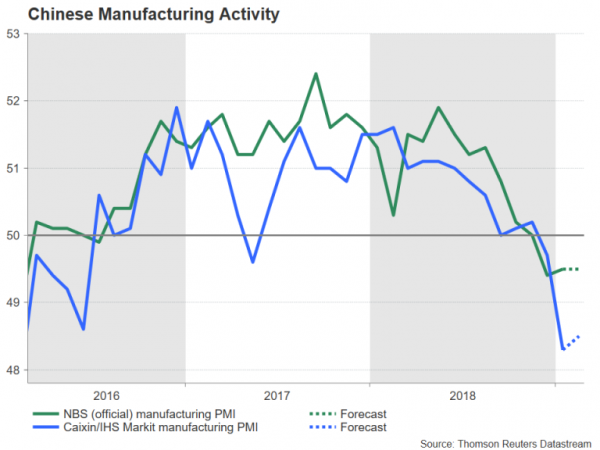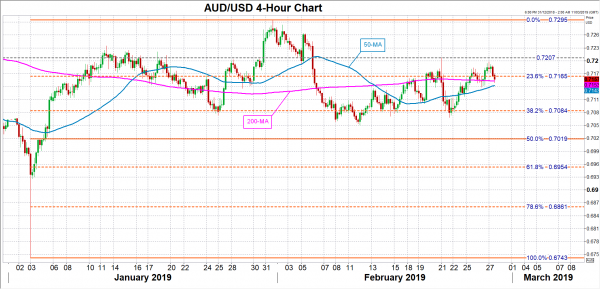Manufacturing PMIs from China this week are expected to show factory activity declining for a third straight month in February even as the US and China close in on a trade deal. The February PMIs will likely be skewed due to the long Lunar New Year holiday during the first week of the month. Nevertheless, investors will be keeping an eye on any hints of a change to the subdued picture, whether positive or negative. In forex markets, the Australian dollar – a liquid proxy for China-related risks – would see the most reaction from any surprises to the data.
The official manufacturing PMI of China’s National Bureau of Statistics is released first on Thursday at 01:00 GMT, together with the non-manufacturing PMI. The manufacturing PMI is forecast to hold steady at 49.5 in February, staying below the 50 level that separates expansion from contraction for the third consecutive month. The non-manufacturing PMI will also be attracting attention on Thursday as a strong rebound in January had raised hopes that conditions in the broader economy may have started to improve.
A second gauge of manufacturing activity will follow on Friday with the release of the Caixin/Markit PMI at 1:45 GMT. The Caixin manufacturing PMI, which includes a larger share of private and small-to-medium sized enterprises in the survey than the official one, is also anticipated to remain below 50. However, a small increase from 48.3 to 48.5 is being forecast for February. China’s exporters have been struggling since the escalation of the tariff war between the US and China in 2018. But the negative pressure on the sector may be starting to ease as the trade talks progress and recently announced stimulus measures kick-in.
The aussie, which is sensitive to Chinese economic indicators due to Australia’s reliance on China for its exports, is at risk of receiving a double blow from negative surprises as important domestic data are also published on Thursday. Aussie/dollar could cross below the 200- and 50-period moving averages (MA) in the 4-hour chart at 0.7153 and 0.7143, respectively. A break below the 50-period MA would increase the downside risks and bring into view another key support around the 38.2% Fibonacci of the upleg from 0.6743 to 0.7295, at 0.7084.
Alternatively, should there be any encouraging signs in the Chinese PMIs, as well as upbeat data out of Australia, aussie/dollar could aim for the February high of 0.7207 before targeting the January top of 0.7295.
Heading into March, the markets’ focus will turn to the National People’s Congress in China that commences on March 5. The annual parliamentary event is typically used by the state to set new policies and announce new economic growth targets. Of specific interest will be new legislation being considered by the government that could help it seal a trade deal with the United States. Parliament is expected to vote on a new foreign investment law that would protect foreign companies’ intellectual property in China as well as restrict state interference in foreign-owned businesses.
If the legislation goes far enough in appeasing the US, it could pave the way for some sort of a trade accord being signed by the two countries in the coming weeks.
















